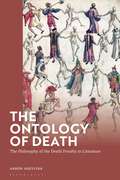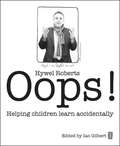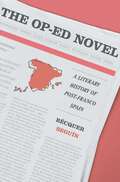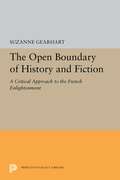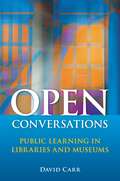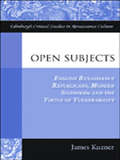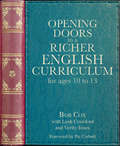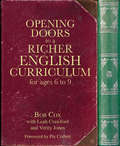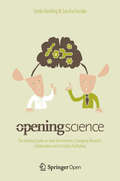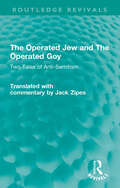- Table View
- List View
Ontology-Based Interpretation of Natural Language (Synthesis Lectures on Human Language Technologies)
by Philipp CimianoFor humans, understanding a natural language sentence or discourse is so effortless that we hardly ever think about it. For machines, however, the task of interpreting natural language, especially grasping meaning beyond the literal content, has proven extremely difficult and requires a large amount of background knowledge. This book focuses on the interpretation of natural language with respect to specific domain knowledge captured in ontologies. The main contribution is an approach that puts ontologies at the center of the interpretation process. This means that ontologies not only provide a formalization of domain knowledge necessary for interpretation but also support and guide the construction of meaning representations. We start with an introduction to ontologies and demonstrate how linguistic information can be attached to them by means of the ontology lexicon model lemon. These lexica then serve as basis for the automatic generation of grammars, which we use to compositionally construct meaning representations that conform with the vocabulary of an underlying ontology. As a result, the level of representational granularity is not driven by language but by the semantic distinctions made in the underlying ontology and thus by distinctions that are relevant in the context of a particular domain. We highlight some of the challenges involved in the construction of ontology-based meaning representations, and show how ontologies can be exploited for ambiguity resolution and the interpretation of temporal expressions. Finally, we present a question answering system that combines all tools and techniques introduced throughout the book in a real-world application, and sketch how the presented approach can scale to larger, multi-domain scenarios in the context of the Semantic Web. Table of Contents: List of Figures / Preface / Acknowledgments / Introduction / Ontologies / Linguistic Formalisms / Ontology Lexica / Grammar Generation / Putting Everything Together / Ontological Reasoning for Ambiguity Resolution / Temporal Interpretation / Ontology-Based Interpretation for Question Answering / Conclusion / Bibliography / Authors' Biographies
Ontology of Communication: Agent-Based Data-Driven or Sign-Based Substitution-Driven?
by Roland HausserThe book gives a comprehensive discussion of Database Semantics (DBS) as an agent-based data-driven theory of how natural language communication essentially works. In language communication, agents switch between speak mode, driven by cognition-internal content (input) resulting in cognition-external raw data (e.g. sound waves or pixels, which have no meaning or grammatical properties but can be measured by natural science), and hear mode, driven by the raw data produced by the speaker resulting in cognition-internal content.The motivation is to compare two approaches for an ontology of communication: agent-based data-driven vs. sign-based substitution-driven. Agent-based means: design of a cognitive agent with (i) an interface component for converting raw data into cognitive content (recognition) and converting cognitive content into raw data (action), (ii) an on-board, content-addressable memory (database) for the storage and content retrieval, (iii) separate treatments of the speak and the hear mode. Data-driven means: (a) mapping a cognitive content as input to the speak-mode into a language-dependent surface as output, (b) mapping a surface as input to the hear-mode into a cognitive content as output. Oppositely, sign-based means: no distinction between speak and hear mode, whereas substitution-driven means: using a single start symbol as input for generating infinitely many outputs, based on substitutions by rewrite rules.Collecting recent research of the author, this beautiful, novel and original exposition begins with an introduction to DBS, makes a linguistic detour on subject/predicate gapping and slot-filler repetition, and moves on to discuss computational pragmatics, inference and cognition, grammatical disambiguation and other related topics. The book is mostly addressed to experts working in the field of computational linguistics, as well as to enthusiasts interested in the history and early development of this subject, starting with the pre-computational foundations of theoretical computer science and symbolic logic in the 30s.
The Ontology of Death: The Philosophy of the Death Penalty in Literature
by Aaron AquilinaThrough examination of the death penalty in literature, Aaron Aquilina contests Heidegger's concept of 'being-towards-death' and proposes a new understanding of the political and philosophical subject.Dickens, Nabokov, Hugo, Sophocles and many others explore capital punishment in their works, from Antigone to Invitation to a Beheading. Using these varied case studies, Aquilina demonstrates how they all highlight two aspects of the experience. First, they uncover a particular state of being, or more precisely non-being, that comes with a death sentence, and, second, they reveal how this state exists beyond death row, as sovereignty and alterity are by no means confined to a prison cell.In contrast to Heidegger's being-towards-death, which individualizes the subject – only I can die my own death, supposedly – this book argues that, when condemned to death, the self and death collide, putting under erasure the category of subjectivity itself. Be it death row or not, when the supposed futurity of death is brought into the here and now, we encounter what Aquilina calls 'relational death'. Living on with death severs the subject's relation to itself, the other and political sociality as a whole, rendering the human less a named and recognizable 'being' than an anonymous 'living corpse', a human thing. In a sustained engagement with Blanchot, Levinas, Hegel, Agamben and Derrida, The Ontology of Death articulates a new theory of the subject, beyond political subjectivity defined by sovereignty and beyond the Heideggerian notion of ontological selfhood.
The Ontology of Death: The Philosophy of the Death Penalty in Literature
by Aaron AquilinaThrough examination of the death penalty in literature, Aaron Aquilina contests Heidegger's concept of 'being-towards-death' and proposes a new understanding of the political and philosophical subject.Dickens, Nabokov, Hugo, Sophocles and many others explore capital punishment in their works, from Antigone to Invitation to a Beheading. Using these varied case studies, Aquilina demonstrates how they all highlight two aspects of the experience. First, they uncover a particular state of being, or more precisely non-being, that comes with a death sentence, and, second, they reveal how this state exists beyond death row, as sovereignty and alterity are by no means confined to a prison cell.In contrast to Heidegger's being-towards-death, which individualizes the subject – only I can die my own death, supposedly – this book argues that, when condemned to death, the self and death collide, putting under erasure the category of subjectivity itself. Be it death row or not, when the supposed futurity of death is brought into the here and now, we encounter what Aquilina calls 'relational death'. Living on with death severs the subject's relation to itself, the other and political sociality as a whole, rendering the human less a named and recognizable 'being' than an anonymous 'living corpse', a human thing. In a sustained engagement with Blanchot, Levinas, Hegel, Agamben and Derrida, The Ontology of Death articulates a new theory of the subject, beyond political subjectivity defined by sovereignty and beyond the Heideggerian notion of ontological selfhood.
Oops!: Helping Children Learn Accidentally (PDF)
by Hywel Roberts Ian GilbertThis book is about engaging learners in great learning. It's about the dance that happens behind positive engagement - the cool moves and steps a teacher needs to choreograph in order to create a context where great learning can happen - and about the importance of relationships in engagement and how rapport can be learned. The book also shines a spotlight on the role of the teacher and how he or she can do the right things to get the absolute best from students. Some of the best learning takes place when, rather than imposing on young people a pre-determined curriculum, you find the stimulus that is relevant and engaging for them and build from there. Then the curriculum starts to emerge in a way that simply hooks students into learning almost despite themselves. There is nothing for them to push against ('What's the point?!' 'This is boring. . !') as they have helped shape the direction of the lesson in a way that makes it real and useful to them. All this without them even realising what is going on! They have been 'lured into learning' and the process is shared with teachers in this book, with examples as to how it can be done and how the author has done it. Reading this book will support teachers in developing ideas that motivate everybody in the classroom, from infants to secondary and beyond. Whether you're new to teaching or have vast experience you will find in this book inspiration to raise achievement, improve behaviour and enhance creativity in the classroom and you will change the way you approach lesson planning forever.
The Op-Ed Novel: A Literary History of Post-Franco Spain
by Bécquer Seguín“The Op-Ed Novel not only elegantly recounts a vital intellectual and cultural history of post-Franco Spain. Carefully exploring the careers of Spain’s most eminent writers, it demonstrates, too, the osmotic links between political journalism and literary fiction—salutary reading in the English-speaking countries, where politics and literature are still regarded as strangers to each other.”—Pankaj Mishra, author of Run and HideA new history of contemporary Spanish fiction through the prism of novelists’ newspaper columns.Public intellectuals come in many different stripes, but most of them gain a following at least in part from their writing, whether in the form of magazine articles, newspaper columns, or full-length nonfiction. A few—James Baldwin and Joan Didion are celebrated examples—start out as novelists before turning to the rough-and-tumble of current affairs. In The Op-Ed Novel, Bécquer Seguín undertakes the first book-length study of how contemporary literature is shaped by opinion journalism, focusing on fiction writers who took to the papers in post-Franco Spain and became stewards of their country’s cultural, economic, and political future.Following Spain’s transition to democracy in the late 1970s and early 1980s, internationally acclaimed novelists such as Javier Cercas, Antonio Muñoz Molina, and Javier Marías seized the opportunity to populate the opinion pages of the newly legal free press. The Op-Ed Novel analyzes how the argumentative styles and preoccupations of their columns in El País, Spain’s most widely read daily, bled into their fiction. These and other authors used their novels to settle scores with fellow intellectuals, make speculative historical claims, and advance partisan political projects. At the same time, their literary technique greatly invigorated opinion journalism.A lively guide to the terroir of contemporary Spanish literature, The Op-Ed Novel offers a bird’s-eye view of both the post-Franco intellectual climate and the changing role of the novelist in public life.
Open-Air Shakespeare: Under Australian Skies (Global Shakespeares)
by R. GabyMany people today first encounter staged Shakespeare in an open-air setting. This book traces the history of open-air Shakespeares in Australia to investigate why the anomaly of adapting 400-year old plays under Australian skies exerts such a strong appeal.
The Open Book: Creative Misreading in the Works of Selected Modern Writers
by M. JensenThe Open Book is a provocative study of literary influence at work in English writing from Hardy to Woolf. Jensen reimagines the links between text and context as she endeavors to historicize literary influence, by taking Bloomian 'anxiety' and Kristevan 'intertextuality' into fields of actual history and biography. Jensen both borrows from and deconstructs the ideas of these theorists as she reads the texts of Hardy, Stephen, Woolf, Mansfield, and Middleton Murry. By doing so, The Open Book offers a fresh and pragmatic opening onto the relation between personal, cultural and institutional history on the one hand, and literary history on the other.
The Open Boundary of History and Fiction: A Critical Approach to the French Enlightenment (Princeton Legacy Library #5455)
by Suzanne GearhartChallenging the view that a critical sense of history is missing from the Enlightenment, Suzanne Gearhart links the works of Voltaire, Montesquieu, Diderot, and Rosseau with the inquiry into the boundary between literature and history in contemporary critical discourse. She considers the theories of Levi-Strauss, Foucault, Althusser, Genette, White, de Man, and Derrida in order to develop a critical approach to fiction and history and to reveal that investigations into the fo undations of historical knowledge, and specifically into what distinguishes hsitory from fiction, were central to the Enlightenment.This book questions many assumptions basic to contemporary criticism by establishing a dialogue between major theorists and Enlightenment figures. It challenges certitudes of fiction and literature by examining the historicity of language, form, and literature itself, redefining history to show its crucial relevance to literary studies and opening historiography to the insights of literary theory.Suzanne Gearhart is Associate Professor of Literature at the University of California, San Diego.Originally published in 1984.The Princeton Legacy Library uses the latest print-on-demand technology to again make available previously out-of-print books from the distinguished backlist of Princeton University Press. These editions preserve the original texts of these important books while presenting them in durable paperback and hardcover editions. The goal of the Princeton Legacy Library is to vastly increase access to the rich scholarly heritage found in the thousands of books published by Princeton University Press since its founding in 1905.
Open Conversations: Public Learning in Libraries and Museums
by David CarrCultural institutions must reimagine their roles as education facilities for their communities and address the public need for conversations in safe and fair places, thereby renewing their essential place in democratic society. This book explains how.Open Conversations: Public Learning in Libraries and Museums is a provocative book, one that is designed to offer courage to cultural institution administrators and staff even as it opens their eyes to the possibility that their facilities can offer more than they are. Rather than offering prescriptive answers, the author invites readers to consider museums and libraries in fresh ways.Author David Carr believes professionals in libraries and museums need to think more broadly. He challenges them to address communities, national social change, psychology, and learning, and to think about ways to frame their institutions, not as repositories or research chambers, but as instruments for human thinking. Now is the time for these institutions to recover their integrity and purpose as fundamental, informing structures in a struggling democracy. Based on lectures and previously published writings by the author, and drawing on new scholarship and research, the essays here will inspire professionals to understand their collections and institutions as instruments of personal, social, and cultural change.
The Open Hand: Arguing as an Art of Peace
by Barry M. KrollBased on five years of classroom experimentation, The Open Hand presents a highly practical yet transformational philosophy of teaching argumentative writing. In his course Arguing as an Art of Peace, Barry Kroll uses the open hand to represent an alternative approach to argument, asking students to argue in a way that promotes harmony rather than divisiveness and avoiding conventional conflict-based approaches. Kroll cultivates a bodily investigation of noncombative argument, offering direct pedagogical strategies anchored in three modalities of learning—conceptual-procedural, kinesthetic, and contemplative—and projects, activities, assignments, informal responses, and final papers for students. Kinesthetic exercises derived from martial arts and contemplative meditation and mindfulness practices are key to the approach, with Kroll specifically using movement as a physical analogy for tactics of arguing. Collaboration, mediation, and empathy are important yet overlooked values in communicative exchange. This practical, engaging, and accessible guide for teachers contains clear examples and compelling discussions of pedagogical strategies that teach students not only how to write persuasively but also how to deal with personal conflict in their daily lives.
The Open Space: Theatre as Opportunity for Living
by Roger GraingerThis book looks at the way theatre works in order to make 'space for living'. It provides the means to help one feel more deeply, think more clearly, relate more personally, by giving audiences and actors the opportunity to rehearse their roles within a setting which is imagined, but to make use of feelings and thoughts which are real. This book extends the territory explored by Peter Brook in The Empty Space. It adds a new psychological dimension: recognising that not only do we ourselves make space for theatre, but it is also true that theatre makes space for us -- a 'space for living'. Roger Grainger looks in turn at the different kinds of space theatre creates, using written sources and the spoken testimony of actors and members of the audience. The author's own discoveries as a professional actor give passion and immediacy to the acting/audience participation opportunities these insights provide. Based on genuine experience of, and love for, the theatre, this book does not present plays solely as literature but as particular kinds of theatrical experience. In so doing the author breaks new ground in theatre studies and provides actors and audience with tools that promote 'hands-on' knowledge and experience of the human value of drama and theatre.
Open Subjects: English Renaissance Republicans, Modern Selfhoods and the Virtue of Vulnerability (Edinburgh Critical Studies In Renaissance Culture Ser.)
by James KuznerStudies of the republican legacy have proliferated in recent years, always to argue for a polity that cultivates the virtues, protections, and entitlements which foster the self's ability to simulate an invulnerable existence. James Kuzner's original new study of writing by Spenser, Shakespeare, Marvell and Milton is the first to present a genealogy for the modern self in which its republican origins can be understood far more radically. In doing so, the study is also the first to draw radical and republican thought into sustained conversation, and to locate a republic for which vulnerability is, unexpectedly, as much what community has to offer as it is what community guards against. At a time when the drive to safeguard citizens has gathered enough momentum to justify almost any state action, Open Subjects questions whether vulnerability is the evil we so often believe it to be. Key features: * First study to explore how early modern republican and contemporary radical thought connect with and complement each other * Traces the presence of English republicanism from the late sixteenth century to the late seventeenth * Analyses Renaissance literary texts in the context of classical, early modern, and contemporary political thought to add to how we think about selfhood in the present * Offers illuminating new readings of the place that English Renaissance figures occupy in histories of friendship, the public sphere, and selfhood more generally
Opening Doors to a Richer English Curriculum for Ages 10 to 13 (Opening Doors)
by Bob Cox Leah Crawford Verity JonesOpening Doors to a Richer English Curriculum for Ages 10 to 13 takes Bob Cox’s award-winning ‘Opening Doors’ series into bold new territories, providing a treasury of techniques and strategies all carefully selected to support the design of a deeper, more creative and more expansive curriculum.Together with Leah Crawford and Verity Jones, Bob has compiled this rich resource to help teachers enhance their learners’ engagement with challenging texts and develop their writing skills as budding wordsmiths. It includes 15 ready-to-use units of work covering a range of inspiring poetry and prose from across the literary tradition, complete with vivid illustrations by Victoria Cox.Bob, Leah and Verity’s innovative ideas on theory, best practice and how to cultivate a pioneering classroom spirit are all integrated into the lesson suggestions, which have been designed for both the teacher’s and the learners’ immediate benefit.Together they empower teachers to explore with their learners the scope and depth of literature capable of inspiring high standards and instilling a love of language in its many forms. Furthermore, they help teachers to lay down intricate curricular pathways that will prompt their pupils to better enjoy literature, read and analyse texts with a greater sense of curiosity, and write with more originality.The book includes a great range of texts both as the core of each unit and as link reading, incorporating some contemporary texts to show how past and present co-exist – and how various literary styles can be taught using similar principles, all of which are open to further adaptation. The authors have also suggested key concepts around which the curriculum can be built, with the units providing examples with which you can work.All of the extracts and illustrations you will need in order to begin opening doors in your classroom are downloadable, and the book also includes a helpful glossary of key terms.Suitable for teachers of pupils aged 10 to 13.Units include:Part 1: Opening Doors to Poetry. 1. Go and Open the Door – ‘The Door’ by Miroslav Holub. 2. One Star – ‘Speak of the North!’ by Charlotte Brontë. 3. Fire in My Head – ‘The Song of Wandering Aengus’ by W. B. Yeats. 4. Among the White Clouds – ‘Cold Mountain’ by Han-Shan. 5. The Bird That Sings – ‘Sympathy’ by Paul Laurence Dunbar. 6. Over It Dashes a Waterfall – ‘A Coloured Print by Shokei’ by Amy Lowell. 7. Old King Time! – ‘Song of Old Time’ by Eliza Cook. 8. Zoom in – ‘The Dong with a Luminous Nose’ by Edward Lear.Part 2: Opening Doors to Prose. 9. Fifty Degrees Below Zero – ‘To Build a Fire’ by Jack London. 10. The Green Door – ‘The Door in the Wall’ by H. G. Wells. 11. The Torpor of Death – The Haunted Hotel by Wilkie Collins. 12. A Home for David – David Copperfield by Charles Dickens. 13. A Ghost Mystery for Flaxman Low – ‘The Story of Baelbrow’ by E. and H. Heron. 14. Shame and Pain – Little Women by Louisa May Alcott. 15. Fake News – In Search of the Truth.
Opening Doors to a Richer English Curriculum for Ages 6 to 9 (Opening Doors)
by Bob Cox Leah Crawford Verity JonesOpening Doors to a Richer English Curriculum for Ages 6 to 9 takes Bob Cox’s award-winning ‘Opening Doors’ series into bold new territories, providing a treasury of techniques and strategies all carefully selected to support the design of a deeper, more creative and more expansive curriculum.Together with Leah Crawford and Verity Jones, Bob has compiled this rich resource to help teachers enhance their learners’ engagement with challenging texts and develop their writing skills as budding wordsmiths. It includes 15 ready-to-use units of work covering a range of inspiring poetry and prose from across the literary tradition, complete with vivid illustrations by Victoria Cox.Bob, Leah and Verity’s innovative ideas on theory, best practice and how to cultivate a pioneering classroom spirit are all integrated into the lesson suggestions, which have been designed for both the teacher’s and the learners’ immediate benefit.Together they empower teachers to explore with their learners the scope and depth of literature capable of inspiring high standards and instilling a love of language in its many forms. Furthermore, they help teachers to lay down intricate curricular pathways that will prompt their pupils to better enjoy literature, read and analyse texts with a greater sense of curiosity, and write with more originality.The book includes a great range of texts both as the core of each unit and as link reading, incorporating some contemporary texts to show how past and present co-exist – and how various literary styles can be taught using similar principles, all of which are open to further adaptation. The authors have also suggested key concepts around which the curriculum can be built, with the units providing examples with which you can work.All of the extracts and illustrations you will need in order to begin opening doors in your classroom are downloadable, and the book also includes a helpful glossary of key terms.Suitable for teachers of pupils aged 6 to 9.Units include:Part 1: Opening Doors to Poetry. 1. I Pulled a Hummingbird Out of the Sky – ‘Wind’ by Dionne Brand. 2. Do You Have Time to Stand and Stare? – ‘Leisure’ by W. H. Davies. 3. Mini-Beast Magic – ‘Hurt No Living Thing’ by Christina Rossetti. 4. How Out of Breath You Are – ‘Dear March – Come In –’ by Emily Dickinson. 5. Voices in an Empty Room – ‘Green Candles’ by Humbert Wolfe. 6. Faceless – ‘Prince Kano’ by Edward Lowbury. 7. Green-Eyed Scratcher – ‘Cat!’ by Eleanor Farjeon.Part 2: Opening Doors to Prose. 8. Foundling – ‘Over the Hills and Far Away’ by Hilary McKay and ‘Blackberry Blue’ by Jamila Gavin. 9. A Power Struggle – ‘The Frost, the Sun, and the Wind’ (Russian folk tale translated by Charles Downing). 10. Stories and More Stories – Granny’s Wonderful Chair by Frances Browne. 11. That Is Disgusting! – The American Woman’s Home by Catherine E. Beecher and Harriet Beecher Stowe. 12. Shadow in a Drawer – Peter Pan by J. M. Barrie. 13. Once Upon a Time There Was a Piece of Wood – Pinocchio by Carlo Collodi. 14. Whirlpools! – ‘The Island of the Nine Whirlpools’ by Edith Nesbit. 15. The Butterfly Dance – The Story of the Blue Planet by Andri Snær Magnason.
Opening Doors to Quality Writing 10-13: Ideas for writing inspired by great writers
by Bob CoxIn Opening Doors to Famous Poetry and Prose, Bob Cox introduced teachers to engaging strategies which use literary heritage texts as the stimulus for excellent learning. This new companion book, Opening Doors to Quality Writing, for ages 10 to 13, puts the focus on pupils producing quality writing – developing their literacy skills and a love of reading in the process. In the course of his educational consultancy work, Bob has seen many teachers successfully use the scope and depth which literature can offer to inspire high standards, mastery learning and, above all, a love of language in its many forms. Schools using the ‘opening doors’ strategies told Bob they led to: more teacher empowerment and confidence; more knowledge building for pupils and teachers; a growing confidence with literature, including poetry; planning from the top becoming a norm; planning for mastery learning becoming a norm; improved comprehension skills; improved quality writing and associated excitement. They also asked Bob for further examples of inspiring, quality texts, and more ways in which all abilities can access them. Bob was only too happy to oblige. These 15 units of work cover poetry and prose: each unit provides exciting stimulus material, creative ideas for writing projects, and differentiation and support strategies, meaning all pupils can achieve the quality writing objectives. All the units should help teachers facilitate understanding of the challenging texts and maximise the huge potential for quality writing. Discover a multitude of ready-to-use ideas, inspired by classic literature and great writers’ works, along with plenty of new strategies and advice. Units include: Part 1: Opening doors to prose 1. Night Encounter – The Woman in White by Wilkie Collins 2. Spooky Scientists! – The Phantom Coach by Amelia B. Edwards 3. The Strongest Looking Brute in Alaska – That Spot by Jack London 4. Mr Knickerbocker’s Notes – Rip Van Winkle by Washington Irving 5. The Portrait of Doom – Tess of the D’Urbervilles by Thomas Hardy 6. The Hell Hound – The Hound of the Baskervilles by Sir Arthur Conan Doyle 7. Sinister Spaces – Metamorphosis and The Castle by Franz Kafka 8. The Mirror and the Window – Wuthering Heights by Emily Brontë Part 2: Opening doors to poetry 9. All in This House is Mossing Over – From ‘Mementos’ by Charlotte Brontë 10. Dancing the Skies – ‘High Flight’ by John Gillespie Magee, Jr 11. The Mystery of the Lonely Merman – ‘The Forsaken Merman’ by Matthew Arnold 12. Making Magic Talk – ‘The Magnifying Glass’ by Walter de la Mare 13. The Spirit in the Garden – ‘A Garden at Night’ by James Reeves 14. A Shropshire Lad – ‘Blue Remembered Hills’ by A. E. Housman 15. The Silver Heel – ‘I Started Early – Took My Dog’ by Emily Dickinson
Opening Doors to Quality Writing 6-11: Ideas for writing inspired by great writers
by Bob CoxIn Opening Doors to Famous Poetry and Prose, Bob Cox introduced teachers to engaging strategies which use literary heritage texts as the stimulus for excellent learning. This new companion book, Opening Doors to Quality Writing, for ages 6 to 9, puts the focus on pupils producing quality writing – developing their literacy skills and a love of reading in the process. In the course of his educational consultancy work, Bob has seen many teachers successfully use the scope and depth which literature can offer to inspire high standards, mastery learning and, above all, a love of language in its many forms. Schools using the ‘opening doors’ strategies told Bob they led to: more teacher empowerment and confidence; more knowledge building for pupils and teachers; a growing confidence with literature, including poetry; planning from the top becoming a norm; planning for mastery learning becoming a norm; improved comprehension skills; improved quality writing and associated excitement. They also asked Bob for further examples of inspiring, quality texts, and more ways in which pupils of all abilities can access them. Bob was only too happy to oblige. These 15 units of work cover poetry and prose: each unit provides exciting stimulus material, creative ideas for writing projects, and differentiation and support strategies, meaning all pupils can achieve the quality writing objectives. All the units should help teachers facilitate understanding of the challenging texts and maximise the huge potential for quality writing. Discover a multitude of ready-to-use ideas, inspired by classic literature and great writers’ works, along with plenty of new strategies and advice. Units include: Part 1: Opening doors to poetry 1. His Waistcoat and Trousers Were Made of Pork Chops – ‘The New Vestments’ by Edward Lear 2. Prefabulous Animiles – ‘The Hippocrump’ by James Reeves 3. Slowly the Tide Creeps Up the Sand – ‘Slowly’ by James Reeves 4. Colour Your World – ‘What is Pink?’ by Christina Rossetti 5. The Nymph and the Goblin – ‘Overheard on a Saltmarsh’ by Harold Monro 6. Pictures in My Head – ‘A Child’s Thought’ by Robert Louis Stevenson 7. He’s Behind You! – ‘The Elf Singing’ by William Allingham 8. The Sounds of Silence – ‘Lonely Street’ by Francisco López Merino 9. Pond Dipping – ‘Daddy Fell into the Pond’ by Alfred Noyes Part 2: Opening doors to prose 10. The Making of World-pap – The Water Babies: A Fairy Tale for a Land-Baby by Charles 11. Master No-book and the Fairy Teach-all – Uncle David’s Nonsensical Story about Giants and Fairies by Catherine Sinclair 12. Turning the Key – The Secret Garden by Frances Hodgson Burnett 13. The Old Oak Chest – The Riddle by Walter de la Mare 14. The Winking Scarecrow – The Wizard of Oz by L. Frank Baum 15. The Psammead – Five Children and It by E. Nesbit
The Opening of the American Mind: Ten Years of The Point
by The PointIn a cultural landscape dominated by hot takes and petty polemics, The Point stands for something different. Informed by the conviction that humanistic thinking has relevance for everyday life, the magazine has long maintained a rare space for thoughtful dialogue between a wide range of political views, philosophical perspectives, and personal experiences: its contributors include liberals and conservatives, philosophers and activists, Marxists and Catholics, New Yorkers and Midwesterners. A little more than a decade since its founding on the campus of the University of Chicago, it offers a unique and revelatory look at the changing face of America, one that speaks not only to way American minds have been forced to “open” by a decade of trauma and transformation, but also to the challenge of remaining open to our fellow citizens during our deeply divided present. Featuring award-winning and highly acclaimed essays from The Point’s first ten years, The Opening of the American Mind traces the path of American intellect from the magazine’s inception in 2009, when Barack Obama was ascending the steps of the White House, to the brink of the 2020 election. The essays, chosen both for the way they capture their time and transcend it, are assembled into five sections that address cycles of cultural frustrations, social movements, and the aftermath of the 2016 election, and provide lively, forward-looking considerations of how we might expand our imaginations into the future. Spanning the era of Obama and Trump, Occupy Wall Street and Black Lives Matter, #MeToo and renewed attention to reparations, this anthology offers critical reflections on some of the decade’s most influential events and stands as a testament to the significance of open exchange. The intellectual dialogue provided by The Point has never been more urgently needed, and this collection will bring the magazine’s vital work to an even broader readership.
The Opening of the American Mind: Ten Years of The Point
by The PointIn a cultural landscape dominated by hot takes and petty polemics, The Point stands for something different. Informed by the conviction that humanistic thinking has relevance for everyday life, the magazine has long maintained a rare space for thoughtful dialogue between a wide range of political views, philosophical perspectives, and personal experiences: its contributors include liberals and conservatives, philosophers and activists, Marxists and Catholics, New Yorkers and Midwesterners. A little more than a decade since its founding on the campus of the University of Chicago, it offers a unique and revelatory look at the changing face of America, one that speaks not only to way American minds have been forced to “open” by a decade of trauma and transformation, but also to the challenge of remaining open to our fellow citizens during our deeply divided present. Featuring award-winning and highly acclaimed essays from The Point’s first ten years, The Opening of the American Mind traces the path of American intellect from the magazine’s inception in 2009, when Barack Obama was ascending the steps of the White House, to the brink of the 2020 election. The essays, chosen both for the way they capture their time and transcend it, are assembled into five sections that address cycles of cultural frustrations, social movements, and the aftermath of the 2016 election, and provide lively, forward-looking considerations of how we might expand our imaginations into the future. Spanning the era of Obama and Trump, Occupy Wall Street and Black Lives Matter, #MeToo and renewed attention to reparations, this anthology offers critical reflections on some of the decade’s most influential events and stands as a testament to the significance of open exchange. The intellectual dialogue provided by The Point has never been more urgently needed, and this collection will bring the magazine’s vital work to an even broader readership.
The Opening of the American Mind: Ten Years of The Point
by The PointIn a cultural landscape dominated by hot takes and petty polemics, The Point stands for something different. Informed by the conviction that humanistic thinking has relevance for everyday life, the magazine has long maintained a rare space for thoughtful dialogue between a wide range of political views, philosophical perspectives, and personal experiences: its contributors include liberals and conservatives, philosophers and activists, Marxists and Catholics, New Yorkers and Midwesterners. A little more than a decade since its founding on the campus of the University of Chicago, it offers a unique and revelatory look at the changing face of America, one that speaks not only to way American minds have been forced to “open” by a decade of trauma and transformation, but also to the challenge of remaining open to our fellow citizens during our deeply divided present. Featuring award-winning and highly acclaimed essays from The Point’s first ten years, The Opening of the American Mind traces the path of American intellect from the magazine’s inception in 2009, when Barack Obama was ascending the steps of the White House, to the brink of the 2020 election. The essays, chosen both for the way they capture their time and transcend it, are assembled into five sections that address cycles of cultural frustrations, social movements, and the aftermath of the 2016 election, and provide lively, forward-looking considerations of how we might expand our imaginations into the future. Spanning the era of Obama and Trump, Occupy Wall Street and Black Lives Matter, #MeToo and renewed attention to reparations, this anthology offers critical reflections on some of the decade’s most influential events and stands as a testament to the significance of open exchange. The intellectual dialogue provided by The Point has never been more urgently needed, and this collection will bring the magazine’s vital work to an even broader readership.
The Opening of the American Mind: Ten Years of The Point
by The PointIn a cultural landscape dominated by hot takes and petty polemics, The Point stands for something different. Informed by the conviction that humanistic thinking has relevance for everyday life, the magazine has long maintained a rare space for thoughtful dialogue between a wide range of political views, philosophical perspectives, and personal experiences: its contributors include liberals and conservatives, philosophers and activists, Marxists and Catholics, New Yorkers and Midwesterners. A little more than a decade since its founding on the campus of the University of Chicago, it offers a unique and revelatory look at the changing face of America, one that speaks not only to way American minds have been forced to “open” by a decade of trauma and transformation, but also to the challenge of remaining open to our fellow citizens during our deeply divided present. Featuring award-winning and highly acclaimed essays from The Point’s first ten years, The Opening of the American Mind traces the path of American intellect from the magazine’s inception in 2009, when Barack Obama was ascending the steps of the White House, to the brink of the 2020 election. The essays, chosen both for the way they capture their time and transcend it, are assembled into five sections that address cycles of cultural frustrations, social movements, and the aftermath of the 2016 election, and provide lively, forward-looking considerations of how we might expand our imaginations into the future. Spanning the era of Obama and Trump, Occupy Wall Street and Black Lives Matter, #MeToo and renewed attention to reparations, this anthology offers critical reflections on some of the decade’s most influential events and stands as a testament to the significance of open exchange. The intellectual dialogue provided by The Point has never been more urgently needed, and this collection will bring the magazine’s vital work to an even broader readership.
Opening Pandora's Box: Phrases We Borrowed From the Classics and the Stories Behind Them
by Ferdie AddisIt has been one of those days. You've worked like a Trojan, displaying titanic strength and stoic endurance to overcome the Herculean labours that have faced you in order to meet that deadline. We regularly employ classically-derived expressions in our everyday language, yet many of us have little understanding of the origin of these common phrases. But an incomplete classical education need no longer be your Achilles heel. Opening Pandora's Box offers a light-hearted yet fascinating look at the stories behind the expressions. For example, did you know that the phrase 'the face that launched a thousand ships' originates from the story of the kidnapping of Helen of Troy, but the actual line comes from a poem by Christopher Marlowe? Opening Pandora's Box provides a useful introduction to classical mythology as well as giving an insight into our language.
Opening Science: The Evolving Guide on How the Internet is Changing Research, Collaboration and Scholarly Publishing
by Sönke Bartling Sascha FriesikeModern information and communication technologies, together with a cultural upheaval within the research community, have profoundly changed research in nearly every aspect. Ranging from sharing and discussing ideas in social networks for scientists to new collaborative environments and novel publication formats, knowledge creation and dissemination as we know it is experiencing a vigorous shift towards increased transparency, collaboration and accessibility. Many assume that research workflows will change more in the next 20 years than they have in the last 200. This book provides researchers, decision makers, and other scientific stakeholders with a snapshot of the basics, the tools, and the underlying visions that drive the current scientific (r)evolution, often called ‘Open Science.’
The Operated Jew and The Operated Goy: Two Tales of Anti-Semitism (Routledge Revivals)
by Jack ZipesOriginally published in English in 1991 and now reissued with a new Preface by Jack Zipes, this book presents and examines the work of two little-known writers, Oskar Panizza and Mynona (Salomo Friedlaender). In Panizza’s chilling story, The Operated Jew (1893), a turn-of-the- century Jew undergoes a series of disfiguring operations that transform him into a ‘European’. The tale mingles loathing with compassion for its title character. Thirty years later, Panizza’s tale was answered by Mynona, an urbane German Jew who turned the story’s tables in The Operated Goy (1922). In his introduction and essays, Jack Zipes explores some of the myths of modern anti-Semitic thought. He also examines parallels between the rise of anti-Semitism in Europe and the violence of Arabs and Israelis in the Middle East, issues which have an enduring relevance and are as pertinent in the 21st Century as when the book was first published.


